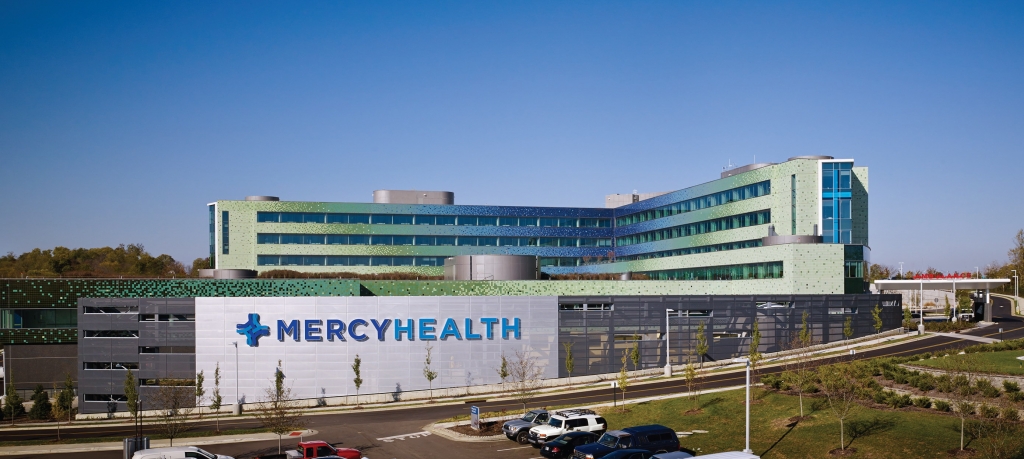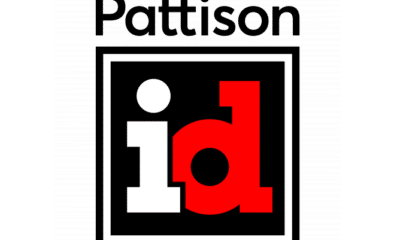As the 78-million-strong, Baby Boomer population ages, the need for effective healthcare facilities has become increasingly acute. General population growth and the quickening pace of today’s inter-
connected society further compound the need for efficient care.
In 2009, Mercy Health, which operates an array of facilities throughout Greater Cincinnati and its environs, began exploring options for a state-of-the-art hospital in western Hamilton County, approximately 10 miles from downtown Cincinnati. AECOM, an international, architectural firm, Champlin Architecture, and Architectural Field Office’s Nic Johnson, FAIA, partnered to develop the plan.
In 2011, Mercy Health approached Kolar Design, also of Cincinnati, about joining a multidisciplinary team to rebrand the Mercy Health System’s more than 170 locations throughout the Cincinnati area. The new facility, known as Mercy West, became a centerpiece of the system’s expansion.
“Everyone involved with Mercy West strived to take a new approach towards healthcare environments,” Kelly Kolar, the firm’s president and chief creative officer, said. “It’s a balance between beauty, culture and function. Connections between architecture, natural light and landscaping promote healing, and anchor the building’s sense of place. Best practices focus on optimizing the patient and staff experience, as well as safety, energy conservation and scalability.”
She said, “Going to the hospital is stressful, so signage must be highly visible to both emergency personnel and visitors. It was important for us to study the route from the highway to the front door, to ensure a welcoming arrival.”
The signs’ color palette incorporates two shades of blue, which Kolar said connote healing and compassion. For the background, Kolar’s team specified brushed silver because of its neutral tone.
Advertisement
She added, “There are many building types throughout the Mercy Health system, so the silver constantly combines with brand elements, and the signage can be integrated into any architecture. Well-designed environments don’t require extensive signage to move the viewer along. The signs’ simplicity complements the architecture, and enables an intuitive wayfinding system that’s insert-based, flexible and scalable.”
Cincinnati’s Holthaus Lackner Signs fabricated the facility’s exterior, main-ID signage and such complementary, architectural signs as the wayfinding pylons outside the main entrance. Scott Holthaus, the company’s vice president, said healthcare signs built for an array of regional providers represent a growing component of the shop’s business.
For the Mercy West project, Kolar provided vector-based .PDFs, which the shop converted into production-ready files using CorelDRAW X6 and SA Intl.’s FlexiSign 8.5 software. Holthaus Lackner built multiple prototypes prior to final approval. They slightly modified some of the sizes to meet zoning codes, but variances were granted for others.
“We designed the environment to contain more signs than were initially permitted by codes, because Mercy West is an important healthcare destination for Cincinnati’s West Side,” Kolar said. “To enhance legibility and safety, the city and county governments allowed us to increase the square footage of campus signage.”
The shop built the monument sign, which measures 6 ft. 6 in. x 15 ft. 2 in., with a 1 x 1-in., aluminum-
tubular frame, with routed, 0.125-in.-thick, aluminum faces and push-through, ¾-in.-thick, acrylic faces. The apparatus was bolted to two, 4-in.-diameter, steel-support tubes, which were buried within the sign’s concrete foundation. The shop MIG-welded the frame together, and routed the aluminum faces and acrylic letters on a MultiCam 3000 CNC router. Fabricators decorated the faces with Avery translucent vinyl that was cut on a Mimaki CG-130 EX cutting plotter. To illuminate the sign, Holthaus Lackner wired the cabinet with 12V, white LED modules.
“Multi-layered, rolled-metal designs such as these can make 3-D sign-fabrication complex,” Holthaus said. “When you’re taking standard, aluminum sheet – rolling it, welding it to an aluminum frame-
work and decorating it with push-through acrylic and vinyl – it requires careful consideration of the materials, equipment and techniques that you’ll use. In Cincinnati, constant temperature fluctuations cause heavy material expansion and contraction, and you have to account for that.”
The entire project, which required approximately 25 custom signs, was executed in just over three months after the contract was finalized. This entailed structural designs, engineer drawings, and zoning and building permits prior to fabrication and installation.
Hightech Signs, also of Cincinnati, fabricated the facility’s interior wayfinding signs. Rob Steiner, the shop’s president, said healthcare signage represents approximately 80% of its volume. He said the shop has built all of Mercy Health’s interior signage for 18 years.
After having worked with Mercy Health’s corporate-design team and Kolar, and having received the original vector art, Hightech prepared cut-ready files using SA Intl.’s FlexiSign 8.5 and Delcam’s ArtCAM 3-D-modeling software.
The job entailed fabricating approximately 3,000 wayfinding and room-ID signs – some were cut on a MultiCam CNC router, and others on a Vytek laser engraver – using 1/8-, ¼- and 3/8-in.-thick acrylic. Steiner noted the strict attention to detail necessary to create signs that bear unique numerals, names and braille characters.
For the ground-floor foyer, Kolar and Ad-Ex Intl., a Cincinnati-based, exhibit-graphics provider, jointly developed a unique donor-recognition statement, which Kolar calls the Heritage and Philanthropy Wall. The piece, which acknowledges the many donors who’ve assisted Mercy Health’s 160-plus-year mission, features a fritted-glass, halo-lit sculpture with modular, etched-glass panels that notate the four levels of donor philanthropy. Madison Design Group (Covington, KY) created an animated, electronic-display component that recognizes the interconnected relationship of patients, staff and donors.
Advertisement



 Paula Fargo2 weeks ago
Paula Fargo2 weeks ago
 Real Deal1 week ago
Real Deal1 week ago
 Photo Gallery2 weeks ago
Photo Gallery2 weeks ago
 Projects1 week ago
Projects1 week ago
 News1 day ago
News1 day ago
 Business Management1 week ago
Business Management1 week ago
 Projects18 hours ago
Projects18 hours ago
 News1 week ago
News1 week ago







